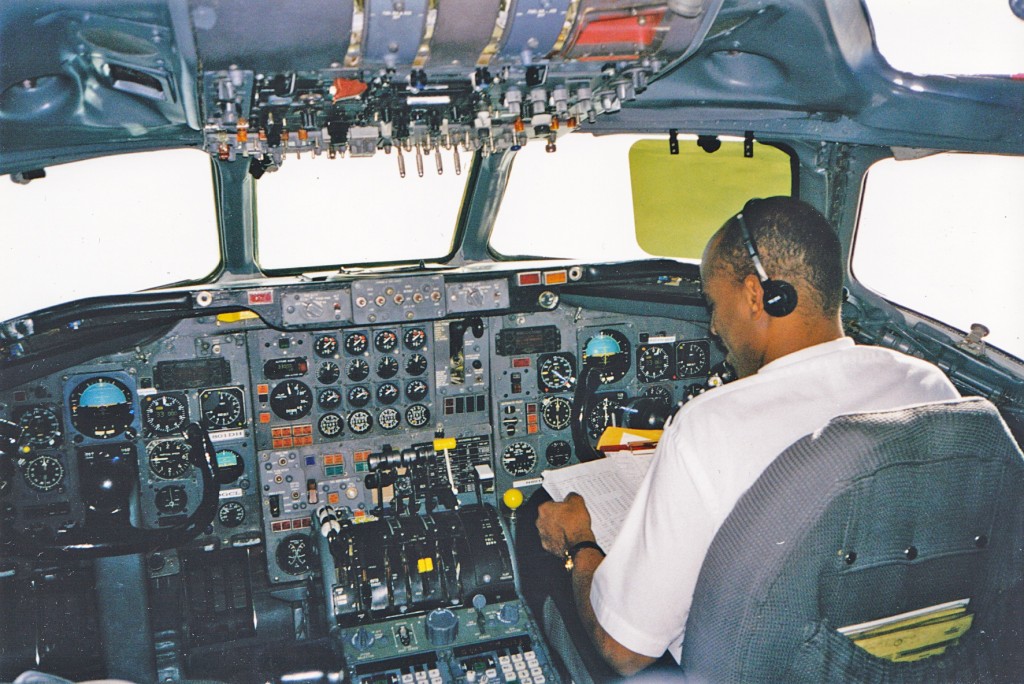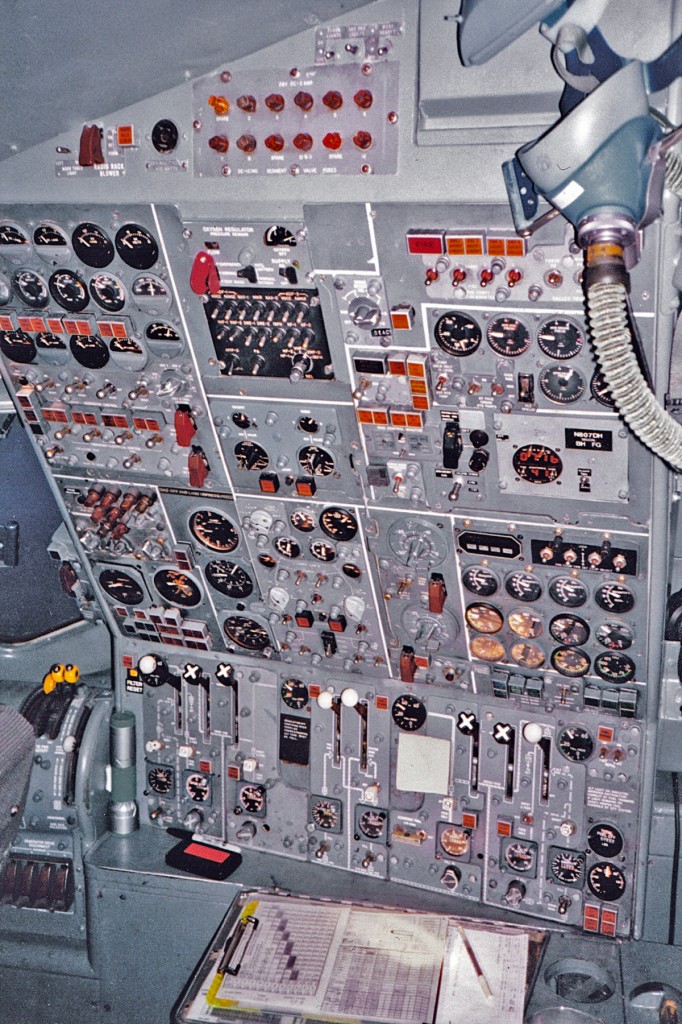EN ROUTE ANGST
Brussels, Belgium, 1998
AT MIDNIGHT AT THE BRUSSELS AIRPORT, three men in olive uniforms stand next to me at a checkpoint. They are straight and tall with skin like cinnamon — that distinct, horn-of-Africa brown. Their suits are crisp and spotless, with gold hash marks and sharply crested hats. The captain looks at his watch, and you can almost hear his sleeve, stiff as aluminum, snapping taut like a sheet.
I am tired and sweaty and the wheels of my luggage need oil. The three men nod without smiling. They are pilots, but the impression they make is closer to one of soldiers, of an elite military unit protecting some corrupt head-of-state. Surreptitiously I read the tags affixed to their cases, and I learn they are a crew from Ethiopian Airlines. Minutes earlier I’d spotted their jet parked on the mist-shrouded tarmac, its old-fashioned livery a throwback to an earlier, more prestigious time: three colored stripes twisting sharply into a lightning bolt, bisected by the figure of the Nubian lion. High on the tail the letters EAL fill three diagonal flashes of red, yellow, and green.
I feel my pulse quicken. “Nice flight?” I ask the captain.
In perfect English he answers. “Yes not too bad, thank you.”
“Where did you come in from?”
“Addis,” he says. And of course he is referring to Addis Ababa, that so mysterious-sounding Ethiopian capital. “By way of Bahrain,” he adds. He speaks quietly, flatly, but his voice is dark and full of command. He’s well over six feet, and it feels that he’s looking down at me from a great distance, sizing me up with the same grievous scrutiny he’d give a bank of approach lights appearing out of the Addis fog.
I look at the first officer, and it strikes me that he’s probably no older than twenty-five, a fact obscured by the seriousness of his uniform. I remember myself at that age, and I’m unable to decide in what amounts his presence mocks or impresses me. Here’s this young man who somehow rose from the rugged, war-torn highlands of East Africa to unprecedented dignity, carrying his nation’s flag to places like Rome and Moscow and Beijing. In his passenger cabin, Ethiopian traders, Russian bankers and Eritrean warriors fling themselves to impossible corners of the world.
And the next time somebody asks why I chose to become an airline pilot, I’ll stammer and stare off, wishing I could just spit out the image of these three men in the doorway. I already know that later I will try to write this down, and when I do it will be impossible to find the right words.
But first is the matter of the Monster, which needs to be preflighted and prepared for the eight-hour crossing to New York.
From the van I catch sight of its ink-dark silhouette, out on the cargo pad, looming out of the murky Zaventem night. “Monster” is my affectionate nickname for the Douglas DC-8. Or not so affectionately, really, as I assume the lumbering hulk of metal is destined, one way or the other, to kill me. Sure, it’s my first jet. And sure, it’s big. But also it’s ancient. The real airlines gave up flying these things nearly two decades ago, and the cockpit looks like something from a World War II Soviet submarine. Hell, the DC-7, its immediate and piston-powered predecessor, had a rudder covered not with aluminum or high-tech composite, but with fabric.
I’m the second officer – the flight engineer – and the preflight is all mine. I work at my own pace. Most guys can, even for an international run, get the DC-8 ready in less than an hour. I stretch it to a meditative ninety minutes. To me there is, or there should be, something Zen about the act of preflighting.
It begins in the cockpit with a flip through the aircraft logbook, making sure the signoffs are there and taking note of items that have recently been deferred. This is followed by an intense, top-to-bottom panel check. Every radio, instrument, light bulb, and electronic box is given the once-over. Then I take a seat at the engineer’s panel — my office, as it were — highlighter in one hand and coffee cup in the other, running through the 20-page flight plan, marking up the important parts: flight time, route, weather, alternates, fuel planning.
When all that’s done, I stock and and set up the galley. Third-in-command on this trawler means preparing the food and emptying the trash. I don’t mind. The cooking duties are a welcome break from the headier duties up front.
Next is the exterior check, or the “walk-around” as we call it. I circle the plane clockwise, eyeing the various lights, sensors, doors and control surfaces. It’s a leisurely, almost peaceful stroll — except for the landing gear bays.
A look into the gear bay of a jetliner is, if nothing else, sobering — the prowess of human engineering starkly unmasked. We take for granted the ease and safety of howling through the air at six hundred miles-per-hour, but a glimpse into the bays shows you just how complex and difficult it all is. An airplane is such a smooth, streamlined thing from afar. Down here, it’s an apocalyptic collection of cables, pumps and ducts. I’m ostensibly checking the tires, inspecting the brakes, scanning for any wayward hydraulics. I’m also looking up at hideous nests of wires, impossible snarls of tubing and struts thicker than tree trunks, shaking my head, wondering who in the name of heaven ever conceived of such a terrifying assemblage of machinery, and who would be stupid enough to trust it all.
Returning to the cockpit, my duties include monitoring and supervising the intake of fuel. This morning we’ll be needing 121,000 pounds of the stuff. That equates to eighteen thousand gallons, to be divided among eight tanks integral to the wings and belly. En route, maintaining proper balance and engine feed requires periodic shifting. The tank valves are opened and shut by a row of eight, hand-operated vertical levers that run across the lower portion of the second officer’s workstation. Trimming up the tanks, I look like a madman trying to play a pipe organ.
Working with lots of fuel means working with lots of numbers. They don’t require anything too elaborate — I’ll add them, subtract them, portion them in half or a quarter — but they are big, six-digit affairs that are constantly changing. That’s bad news for me because I’m terrible at math. It’s funny, because I often hear from aspiring pilots-to-be worried that below-average mathematics skills might keep them grounded. There’s a lingering assumption that airline pilots are required to demonstrate some sort of Newtonian genius before every takeoff — a vestige, maybe, from the days when airmen carried slide rules and practiced celestial navigation. “Dear Patrick, I’m a high school junior who hopes to become a pilot, but my B-minus in honors level pre-calculus has me worried. What should I do?”
What these people don’t realize is that I would have killed for a B-minus in elementary algebra. My final report card from St. John’s Prep, class of 1984, reads something like this: B, C, B, A, D-. That’s math at the end. I can only vaguely define what pre-calculus might be, and I frequently struggle to make change for a dollar or balance my checkbook without electronic assistance.
Modern flight management systems take care of most of the number-crunching, but on older planes you did have to run some quick mental arithmetic: “Okay, if we need to be at 14,000 feet in 60 miles, assuming a 2,000 foot-per-minute descent and 300 knots groundspeed, at what point should we start down? It’s a sort of high-altitude SAT question, with ATC and the rest of your crew assuming you know the answer.
Thus the most indispensable gauge in the DC-8 was not furnished by the designers at Douglas, who built this hideous ark back in the mid-1950s, when men were men and could fly and do long division at the same time. I’m referring to my $6.95 calculator from CVS — the one flight-bag accessory more indispensable than an emergency checklist, aircraft deicing guide, or bag of ramen noodles. Mine is decorated with Day-Glo orange stickers, applied in mortal fear that I might otherwise leave it behind.
Fueling takes half an hour. And now, from outside, comes the diesel roar of a pallet-lifter. Out on the apron sits a disordered array of boxed and shrink-wrapped cargo, tonight about fifty tons of it, waiting to be packed on board. A glance into the freight deck, while it’s still empty, is like peering through a long, empty highway tunnel. I walk back there sometimes, imagining what that space must have looked like twenty or thirty years ago, when the plane carried passengers for Air Canada. In 1982, I flew to Jamaica with my family on an Air Canada DC-8. This very one, possibly.
Me and the monster. These pre-departure routines have a way of enhancing our love/hate relationship. The DC-8 speaks to me. I will kill you, it says, if you don’t take proper care of me.
So, I take proper care.
In a drizzly predawn darkness we lift off.
It’s eight-plus hours to New York. That’s nothing by modern standards, but still it’s a long time. We’re somewhere south of Iceland I’ve got my shoes off. Foil trays of half-eaten chicken sit on the floor, and a trash bag is bursting with discarded cups and cans of Coke Light.
Transoceanic flying induces a unique feeling of loneliness. Out here, you are on your own; there is no radar coverage or conventional air traffic control. Flights are spaced apart by time and speed, sequenced along paths of latitude and longitude. We report our positions to monitoring stations hundreds, even thousands of miles away, silently via satellite link — or, in the case of the old DC-8, over high frequency radio. There’s something in the crackle and echo of an HF transmission that intensifies a sense of isolation.
“Gander, Gander,” calls the captain. “DHL zero one one, position. Five eight north, three-zero west at zero five zero-four. Flight level three-six zero. Estimate five eight north, four zero west at zero five four six. Next, five six north, five zero west. Mach decimal eight five. Fuel seven two decimal six, over?” That’s our current location; ETA for the next reporting fix; speed, altitude, and remaining fuel. A moment or two later comes the acknowledgment from a controller in far-off Newfoundland, his voice so faint he may as well be on the moon.
For the second officer, the cruise phase is pretty relaxed. There’s not much to do, and thoughts will wander — sometimes in the wrong direction, resulting in a distinctly maudlin karmic brew:
In an interview years ago, the novelist Kurt Vonnegut was asked how he’d choose to die. “In a plane crash on Mount Kilimanjaro,” was his answer. And if you think about it, there’s something poetic, almost romantic about that—a jet getting lost in the fog, smacking into the side of that big Tanzanian mountain.
Granted, you’d be hard pressed to find people who think of airplane crashes as anything but the cold hard triumph of gravity over some hulking contraption, but for those of us in love with air travel there can be something almost mystical about them. It’s not the Hollywood stuff — the explosions, the fireballs, and all that. It’s a deeper thing that requires a context and the passage of time — the disaster as a nugget of history, spiced with drama and mystery. But only certain crashes can lay claim to this special aura. Lockerbie and Tenerife have it; most others, however, do not. Sometimes there’s mystique, but usually there’s nothing but the sorrow of a violent death.
This is what I’m pondering, midflight across the Atlantic Ocean. And it’s that latter category, I figure – that most mystique-less and prosaic of crashes — that awaits us should we plummet to a sudden and watery doom. Three guys in a cargo plane? We’d be lucky to get a mention in the paper. How demoralizing.
A pilot’s worst nightmare, other than his airline going bankrupt or the caterers forgetting the meals, is an onboard fire. This old jet has two identical fire detector systems for its 150 foot-long upper cargo deck. These are rotary dial things with yellow annunciator bulbs at the bottom. The bulbs say: CARGO SMOKE. Of course, this is an airplane dating to the time when Eisenhower still had a comb-over, so guess what? Thanks for the heads-up, but there’s nothing to actually put the fire out with once it has been detected. (DC-8s are all but extinct, and were taken out of the passenger-carrying business a long time ago, so don’t worry.) There are bigger, brighter lights in this cockpit, but it’s those square, innocuous-looking yellow lights that I do not ever want to see come on, particularly when the closest spot of land, two hours away, is the glaciered coast of Greenland.
I’m also aware that in the compartment behind us are twenty thousand pounds of fresh-cut flowers from Belgium and the Netherlands headed to America. The scent of the flowers has made the cockpit smell like baby powder. And it so happens that when thousands of pounds of flowers are piled together, they tend to release clouds of microscopic dust—tiny bits of pollen and chaff that fill the air with a kind of fragrant fog. Meanwhile, the DC-8’s old-fashioned detectors are designed to detect not flames or heat but smoke particles, and are very susceptible to false alarms triggered by, that’s right, dust or powder.
So I’m staring at the warning lights, waiting for them to tell me we’re on fire over the middle of the ocean. Or is it only dust? And I think about how, after planes crash at sea, they go out on a boat and toss flowers into the waves, and how if something happened and we found ourselves in a watery grave, we’d save everyone the trouble by spreading a veritable slick of tulips halfway to Labrador.
Making matters worse, the captain takes out a chart and starts playing with the GPS. “Ha!” he shouts. Bored and curious, he has plotted the exact latitude and longitude of the wreck of the Titanic, which is 40,000 feet below us (28,000 of air and 12,000 of salt water), just a short ride south of our course.
“Oh come on,” I say, “Don’t be doing stuff like that.”
I sit in front of my instrument panel — a wall of dials and switches, all arranged in a perfect working sequence, with a collective purpose nothing short of mechanical infallibility. Green lights, red lights, blue lights, circular windows with quivering white needles. In modern planes it’s all liquid crystal or LED, but these are the old-style analog gauges, which give the cockpit that U-boat look. Old, and dizzyingly complex for just that reason. I slide back my seat and consider it all, with the criticism and respect an artist might give to his canvas.
In that moment I am a maestro of ordered technology. But if only you could see what lurks behind that console. The maintenance people sometimes take the panels off, and there’s pandemonium back there: wildly knotted bundles of wires and cables, like a spaghetti factory has exploded. Most people have never seen the guts of an airplane — those vast and complex blocks of machinery conspiring to fool gravity. When you look at the eyes of a pretty girl — that superficial beauty of an iris in the sunlight, do you consider the tangle of optic nerve behind it? And in that brain of hers, what is she thinking? Like a fire secretly smoldering behind me, amid all those flowers. And when it’s finally too late: CARGO SMOKE.
No, not this time. And a few hours later we’re safe at Kennedy.
And doesn’t it always end this way? Amazing that it all works, all those wires and pumps and moving parts — almost infallibly and every time. But it does, and that’s the point about these spooky ruminations. It’s our imagination, not our technology, that is prone to failure.
The other lesson here is that we’re all afraid of flying on some level, and that it’s perfectly healthy to be that way. Even, or particularly, if you’re a pilot. Passengers will ask pilots if we’re ever frightened; do we consider the possibility that the next flight could be our last? This always has struck me as both a profound and asinine question. “Yes,” I’ll answer. “Our job, in essence, is the management of contingency. So sure I’m scared. I have to be scared.”
You can take that with the wink it deserves, but it contains a nugget of truth. Fires, explosions, physics gone bad—all the nasty scenarios the simulator instructors love—it’s all there, coiled behind the instrument panel, waiting to spring in a game of comfortable, though never perfect odds. And the pilot’s role is to spring right back. Do pilots worry about crashing? Of course they do. As a matter of practicality, they need to. It’s their job. It’s in their best interest, and yours as well.







